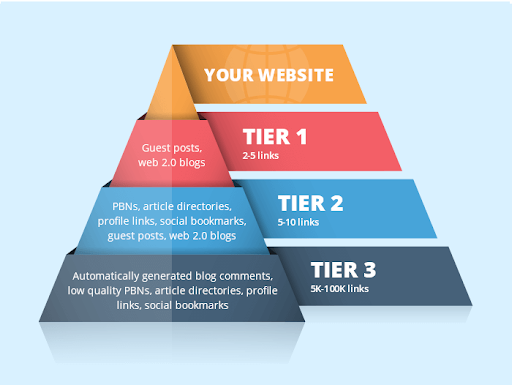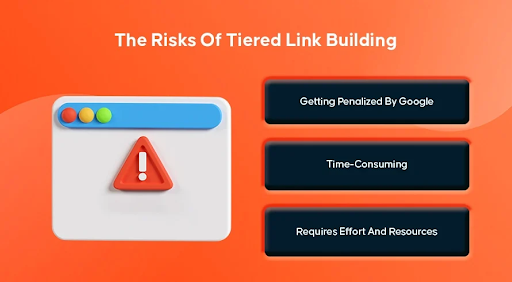What Is Tiered Link Building And Some Common Mistakes To Avoid With?
Digital marketing strategies continually evolve to stay competitive in the online landscape. In this ever-changing environment, mastering the art of link building is crucial for enhancing a website’s visibility and authority. One advanced technique that has gained prominence is Tiered link building, a strategic approach that involves creating a structured hierarchy of backlinks to boost a website’s SEO performance.
– 20 mins

Tiered link building is not a new concept—its effectiveness lies in its systematic implementation. By creating tiers of links, each serving a specific purpose, this method aims to enhance the overall strength of the link profile and improve search engine rankings. In this blog, we’ll delve into the intricacies of Tiered link building, unraveling its core principles and shedding light on its significance in present-day SEO strategies.
However, like any powerful tool, Tied link building requires careful navigation to avoid pitfalls. In the latter part of this blog, we will explore some common mistakes that marketers often make in their Tiered link building endeavors. Understanding and sidestepping these pitfalls is essential for ensuring that link-building efforts contribute positively to your website’s authority and online presence.
Let us walk you through the journey of tiered link building, discover key strategies and common mistakes to avoid, and get better at building a strong online presence.
Understanding Tiered link building
Tiered link building is a strategic approach in search engine optimization (SEO) that involves creating a tiered structure of backlinks to improve a website’s search engine ranking. This technique aims to provide a more natural and diversified link profile, which search engines often view more favorably. SEO practitioners can build a strong foundation of high-quality links by organizing links into different tiers while avoiding potential penalties for aggressive or unnatural link-building practices.
Key components of Tiered link building
Tier 1 backlinks (Direct links to the target site)
This top tier consists of high-quality, authoritative links pointing directly to the target website. These links are typically obtained from reputable and relevant sources within the industry. Tier-first links carry the most SEO value and directly contribute to the target site’s authority.
Some good examples of tier 1 backlinks are:
- Editorial links from reputable news websites
- Guest posts on authoritative blogs in your niche
- Links from well-established and high-authority industry websites
- Social media links from verified and popular accounts.
Tier 2 backlinks (Links to Tier 1)
The second tier involves creating links that point to the websites in the first tier. While these links may not be as authoritative as Tier 1 links—they are crucial in reinforcing and strengthening the first-tier links. Tier second links can be obtained from a variety of sources, including niche blogs, social media platforms, forums, or other reputable websites.
Examples of tier 2 backlinks are:
- Links from forums and discussion boards
- Social bookmarking sites
- Niche-specific directories
- Links from articles on Web 2.0 platforms (e.g., Medium, Blogger).
Tier 3 and beyond backlinks (Supporting links)
Subsequent tiers consist of links that support and reinforce the tiers above them. These links may be more in numbers but are generally of lower quality than higher tiers. They can be generated from Web 2.0 properties, article directories, or other sources. These links support the overall link profile and contribute to a gradual and natural link-building strategy.
Some examples of Tier 3 backlinks include:
- Comments on blog posts
- Forum profile links
- Automated or low-quality directory submissions
- Links from less reputable social bookmarking sites.

Types of Tiered link building
- Pyramid structure
In this type, the link structure resembles a pyramid, with Tier 1 at the top, followed by Tier 2, and so on. The pyramid structure emphasizes the importance of high-quality, authoritative links in the top tier, gradually tapering to a broader base of supporting links. This approach aims to mimic a natural link profile.
- Wheel or circle structure
The wheel or circle structure involves creating a central hub (Tier 1) with spokes (Tier 2) radiating out from it. The spokes link back to the central hub and may also interconnect with each other. This design aims to distribute link equity more evenly throughout the structure while focusing on the central target site.
- Chain structure
In a chain structure, each tier links to the next one in a linear fashion. This can be a simpler approach compared to the pyramid or wheel structures. However, it’s essential to ensure that each link in the chain contributes positively to the overall link profile.
Best practices and considerations
Quality over quantity
Emphasize obtaining high-quality links rather than focusing solely on quantity. Quality links from authoritative sources have a more significant impact on SEO.
Relevance and diversity
Ensure the links obtained are relevant and niche driven to the target site. A diverse range of link sources contributes to a more natural and organic link profile.
Consistency and gradual growth
Implement tiered link building as part of a consistent and gradual growth strategy. Sudden spikes in link acquisition may raise red flags with search engines.
Monitor and analyze
Regularly monitor the performance of your tiered link building campaign. Use SEO tools like Google Analytics and Google Search Console to track changes in ranking and traffic.
What is the significance of Tiered link building?
The structure in tiered link building is crucial for several reasons. It is a foundational aspect that contributes to the overall effectiveness and sustainability of the link-building strategy.
Here are some of the details of why Tired link building is significant:
- Authority flow
A well-structured tiered link building approach helps in the smooth flow of authority from high-authority sites to your target page.
How it works
The top tier consists of high-quality, authoritative links pointing directly to your main site. The subsequent tiers link to each other and the top tier, creating a hierarchy that channels authority down to the target page.
- Relevance and context
Structuring links ensure that the context and relevance of the content are maintained throughout the link network.
How it works
Each tier can focus on a specific aspect of the overall topic or keyword. This maintains thematic relevance and signals to search engines that the links are contextually related.
- Natural linking patterns
Search engines are wary of unnatural link-building patterns. A well-structured tiered approach helps mimic natural linking.
How it works
Natural links often have a pyramid-like structure, with a few high-quality links at the top and a broader base of lower-quality links. Mimicking this pattern in tiered link building makes the strategy appear more organic to search engines.
- Risk mitigation
A structured approach minimizes the risk of over-optimization, spammy link building, or other practices that could trigger search engine penalties.
How it works
By carefully planning and organizing the tiers, you can avoid common pitfalls and ensure that the link-building strategy appears genuine and compliant with search engine guidelines.
- Enhanced control
A structured tiered link building strategy gives you better control over the quality and relevance of the links.
How it works
You can decide which links go into the top tier, how they cascade down to lower tiers, and what types of sites are included in each level. This control allows for a more strategic and targeted approach.
- Adaptability
Search engine algorithms and industry trends can change. A well-structured approach allows for easier adaptation to these changes.
How it works
If a specific tier or type of link becomes less effective or risks penalties, you can adjust your strategy by modifying or removing that tier without disrupting the entire link-building structure.

Some common Tiered link building mistakes to avoid
Tiered link building is a strategy where you create a structured link network, often involving multiple tiers of links pointing to a target site. Successful tiered link building requires careful planning, attention to detail and a firm commitment to staying current with SEO best practices.
While this approach can be effective when executed correctly, there are several common mistakes that you should avoid:
Mistake#1—Over-optimization and anchor text stuffing
One of the primary mistakes is over-optimizing anchor text. Using the same keyword-rich anchor text across all tiers can trigger search engine penalties. Diversify anchor text to maintain a natural link profile. Focus on using relevant, varied phrases to avoid looking spammy and improve the overall link quality.
Mistake#2—Poor quality tier 1 links
The first tier is crucial; using low-quality or irrelevant websites can undermine your entire strategy. Ensure that your Tier 1 links are from reputable, authoritative sources. High-quality Tier 1 links provide a strong foundation for the entire link pyramid, impacting the effectiveness of subsequent tiers.
Mistake#3—Neglecting content quality
Creating subpar content for lower-tier links is a common mistake—content quality matters throughout the tiered structure. Engaging, valuable content helps maintain the integrity of your link building strategy and ensures that each tier contributes positively to your website’s authority.
Mistake#4—Ignoring relevance between tiers
The lack of thematic relevance between tiers is a significant mistake. Each tier should logically connect, with content and context flowing smoothly. Relevance reinforces the authority of the entire structure, so ensure that the topics and themes align coherently from tier to tier.
Mistake#5—Rapid and unnatural link growth
Rapidly building links, especially in the lower tiers, can trigger algorithmic red flags. Mimic natural link growth by gradually increasing the number of links. A sudden influx of links can be interpreted as manipulative, potentially resulting in search engine penalties.
Mistake#6—Neglecting diversity in link sources
Relying solely on one type of link source (e.g., blog comments or guest posts) can be problematic. Diversify your link profile by incorporating various sources like social media, forums, and industry-specific websites. A diverse link profile appears more natural to search engines and reduces the risk of penalties.
Mistake#7—Inadequate monitoring and adjustment
Failing to monitor the performance of your tiered link building strategy is a common error. Regularly assess the impact of your links on search rankings. If certain tiers are not delivering the desired results or if there are signs of penalties, be prepared to adjust your approach accordingly.
Mistake#8—Ignoring changes in search engine algorithms
Search engine algorithms are dynamic and can change frequently. Ignoring algorithm updates and continuing with outdated practices can harm your website’s SEO. Stay informed about algorithm changes and adjust your tiered link building strategy to align with current best practices.
What are the risks of Tiered link building?
Tiered link building is a strategy in search engine optimization where backlinks are built in a hierarchical structure, typically involving multiple tiers of links to influence search engine rankings. While this strategy can be effective, it comes with several risks.
Some of these risks include:
#1. Google penalties
Tiered link building refers to a strategy where links are built in a hierarchical structure, with different tiers supporting each other to enhance the overall link profile of a website. While this technique can effectively boost SEO rankings, it comes with inherent risks, especially regarding Google’s guidelines and algorithm updates.
One significant risk factor is the potential for penalties from Google. Google values organic and natural link-building practices and penalizes manipulative tactics to inflate a site’s authority artificially.
Google’s algorithms are becoming increasingly sophisticated in detecting link schemes and manipulative practices. Suppose Google identifies a website engaging in tiered link building or link manipulation. In that case, it may impose penalties, ranging from a decrease in organic rankings to a complete removal from search results.
#2. Unnatural link patterns
Search engines analyze link patterns to assess the authenticity of a site’s backlink profile. Tiered link building often creates unnatural link patterns, as websites link to each other in a structured and orchestrated manner. When these unnatural link patterns are detected in the context of tiered link building, the risks escalate.
Unnatural link patterns can include excessive backlinks, link exchanges, or using private blog networks (PBNs) to manipulate link authority. The risk of penalties increases when there’s a clear attempt to deceive search engines by creating tiers of interconnected pages solely to pass link equity.
It’s crucial to adopt ethical and transparent SEO practices. Focusing on organic link building through creating valuable content, outreach efforts, and building relationships within the industry can help maintain a natural link profile, reducing the likelihood of penalties associated with unnatural link patterns in tiered link building.
#3. Quality of Tiers
If the lower tiers of a link-building structure contain low-quality or spammy links, it can negatively impact the overall SEO efforts. Search engines aim to reward high-quality content and genuine, organic link building, so relying on low-quality links can be counterproductive.
Tiered link building involves creating a structured hierarchy of links, typically with different levels or tiers of web pages that link to each other, ultimately leading to the target site. The quality of these tiers plays a pivotal role in determining the success and safety of this SEO strategy.
#4. Algorithm updates
Search engines, particularly Google, regularly update their algorithms to refine search results, enhance user experience, and combat manipulative SEO practices. These updates aim to identify and penalize tactics that violate search engine guidelines, and tiered link building, if not executed carefully, can be susceptible to algorithmic scrutiny.
First, if the algorithm evolves to better detect patterns associated with artificial link structures or manipulation, websites employing tiered link building may suddenly drop rankings.
Secondly, Algorithm updates may introduce new criteria for evaluating link quality. If a website’s tiered link structure is built on low-quality or irrelevant sources, it could be negatively affected by algorithmic changes that prioritize high-quality, contextually relevant links.
#5.Relevancy issues
If the links within the tiers are irrelevant to the target page’s content, it may be an attempt to manipulate search rankings. Relevancy is a crucial factor in SEO, and irrelevant links can cause decreased credibility and trust from search engines and hamper your lead generation strategy.
One significant risk is that search engines, especially Google, prioritize contextually relevant links in their algorithms. If the links within the tiers are not relevant to the content or theme of the target site, it may signal to search engines that the link structure is artificial or manipulative. This can diminish trust and credibility, leading to potential penalties or declining search rankings.
Moreover, if the links are perceived as irrelevant by users, it may impact the website’s overall user experience. Visitors are more likely to engage with coherent and logically connected content. Irrelevant links can disrupt the user journey, increasing bounce rates and decreasing user satisfaction.

It's your turn to eliminate all the tedious tasks for good and initiate tiered link building now!
Tiered link building is a strategic approach to improving your site’s search engine positioning by creating a structured network of links. By organizing links into tiers based on their quality and relevance, this technique aims to enhance the overall effectiveness of the link-building process.
However, it’s crucial to be mindful of common mistakes to avoid negative impacts on SEO efforts. By understanding the fundamentals and steering clear of these pitfalls, marketers can harness the power of tiered link building to boost their website’s visibility and authority in search engine results.

Surrinder Pandita is a content writer at RankHandy. He has more than 6 years of experience writing for the marketing, HR, and business sectors and aims to provide high-quality content.





